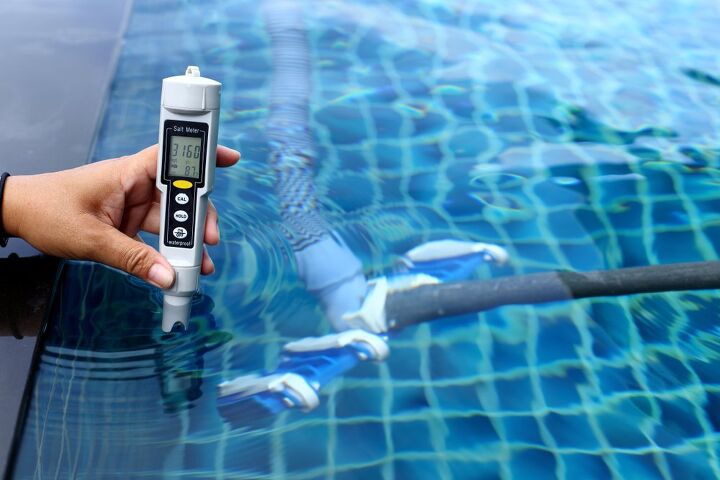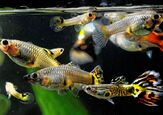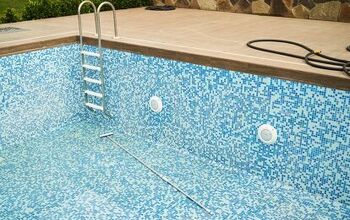How Long After Shocking A Pool Can You Swim? (Find Out Now!)

It is a great practice to regularly shock your pool, and timing is a big part of that. You always want your pool to be safe and clean, and it takes strong chemicals like shock to do that. It can be tempting to jump in the clean water, but how after shocking a pool can you swim?
You can swim after up to 24 hours after you shock the pool. It is also safe to wait for one hour per pound of shock before you swim to avoid side effects like nausea, skin irritation, and coughing. Test your water before you swim when you shock the pool, and only get in if it’s at 1.0-3.0 parts per million.
Do You a Need Pool, Spa, or Hot Tub Contractor?
Get free, zero-commitment quotes from pro contractors near you.

Swim After Shocking Pool
It can be a major temptation to swim after you shock the pool. However, the high concentration of chlorine in shock does not make it ideal for even a quick swim. Shock often contains 70%-80% concentrated chlorine, and that is too much to safely swim in.
Powder and liquid shock can often leave the water cloudy, and that can be a sign to stay out. Shock is significantly stronger than chlorine pucks, and they are great for emergency usage.
Is It Safe To Swim After Shocking a Pool?
No, it is not safe to swim after shocking a pool until you wait up to 24 hours. Waiting time varies based on how much shock you use, and how big your pool is. It is unsafe to swim in a pool with that much chlorine, and health risks include:
- Rash
- Skin irritation
- Coughing
- Sore throat
- Nausea/vomiting
- Asthma attack
You can even risk your life if you use too much shock and swim right away. Some people are more sensitive to chlorine than others, but it can be dangerous for anyone. You can become ill if you accidentally ingest pool water, and nausea and vomiting are common side effects.
When Can I Swim After Shocking Pool?
Wait at least one hour for each pound of shock that you use before you get in the pool. After that time passes, test your pool water to see if there is too much chlorine. Make sure that the water has 1.0-3.0 parts per million chlorine content before you get in the water.
It often takes 12-24 hours for a large pool to reach a balanced and safe chlorine level after shocking. You can try to dilute the chlorine content if you are eager to get in the pool quickly. However, you may lower the free chlorine content in the pool if you add fresh water to dilute the shock.
It is best to stick to the hour-per-pound rule and wait it out to avoid skin irritation, nausea, and rash. You can always test the water during that time and get in the pool sooner if the levels are safe.
Pool Shock vs. Chlorine
Any homeowner with a pool knows that you need to use both pool shock and chlorine to maintain a pool. It is less clear, however, what makes them stand apart when they seem like similar chemical treatments. Let’s take a look at the difference between pool shock and chlorine.
Chlorine
Chlorine is a chemical that can kill germs and keep your pool safe from bacteria and algae. You can find chlorine in several forms, such as liquid and pucks, and you need to maintain proper levels. Bacteria can render chlorine useless if you don’t use enough, and it can disappear if you use too much stabilizer.
Regularly maintain your chlorine levels so that emergencies, such as cloud water, don’t pop up. Think of chlorine as an extended-release sanitation chemical. The chlorine will continually sanitize the water and kill germs before they allow algae to bloom.
You can simply put chlorine pucks in your skimmer box and let them dissolve and dissipate. It is safe to swim in your pool when there are chlorine pucks, but you need to test the chlorine level first.
Shock
Shock isn’t much different from chlorine in the sense that it contains chlorine but in higher concentrations. Pool shock can contain as much as 70%-80% chlorine, and that high concentration can immediately raise chlorine levels. The intense concentration of chlorine that shock provides is enough to kill germs, algae, and waterborne illnesses.
Many homeowners see shock as an emergency solution for algae and green or cloudy water. However, you can shock your pool once a week to keep your chlorine balanced and prevent problems. Shock works in emergencies when you need to quickly balance the chlorine in your pool.
You can find shock in liquid and powder or crystal form. It is best to evenly distribute shock throughout your pool to kickstart the sanitizing effects.
Related Questions
Does shock kill algae?
Yes, shock does kill algae if it has a high chlorine content. You can successfully kill algae with a 70% chlorine concentration. Treat your pool with algaecide 12-24 hours after you shock it to completely eradicate the algae. It may take up to 3 treatments to kill the algae.
Is liquid or powder shock better?
Liquid and powder shock are both effective, but liquid shock works faster and is more cost-effective. Powder shock can take a few minutes to dissolve, but liquid shock works immediately. You can refill liquid shock cheaply, and it makes pool maintenance easier.
Do You a Need Pool, Spa, or Hot Tub Contractor?
Get free, zero-commitment quotes from pro contractors near you.

Related Articles
Summing It Up
You can swim after you wait one hour per one pound of shock, and that can take up to 24 hours. Shock contains 70%-80% chlorine, and that can cause rash, nausea, vomiting, and asthma attacks. Test your pool water to make sure that it contains 1.0-3.0 parts per million (ppm) chlorine before you can safely swim.
Pay attention to how much shock you use and adjust your wait time accordingly. Never get in the pool right away if the water is still cloudy after shocking.

Nick Durante is a professional writer with a primary focus on home improvement. When he is not writing about home improvement or taking on projects around the house, he likes to read and create art. He is always looking towards the newest trends in home improvement.
More by Nick Durante















![How Much Weight Can a 4×4 Support Horizontally? [It Depends!]](https://cdn-fastly.upgradedhome.com/media/2023/07/31/9070333/how-much-weight-can-a-44-support-horizontally-it-depends.jpg?size=350x220)
![The 10 Best Table Saws - [2022 Reviews & Buyer's Guide]](https://cdn-fastly.upgradedhome.com/media/2023/07/31/9070645/the-10-best-table-saws-2022-reviews-buyer-s-guide.jpg?size=350x220)


![Cost To Drill A Well [Pricing Per Foot & Cost By State]](https://cdn-fastly.upgradedhome.com/media/2023/07/31/9074980/cost-to-drill-a-well-pricing-per-foot-cost-by-state.jpg?size=350x220)









